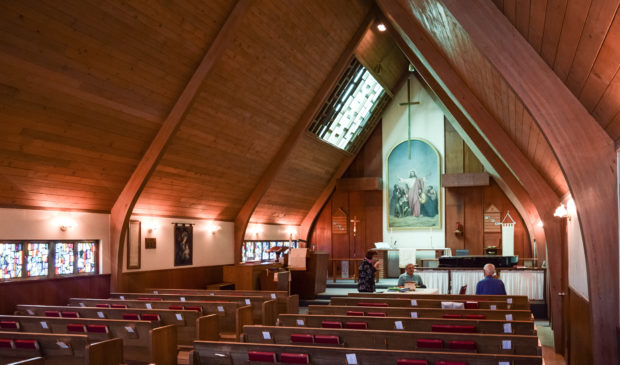In the midst of preservation push, city permits demolition of church
Thursday, November 7, 2019 by
Jessi Devenyns After the Historic Landmark Commission initiated historic zoning for the Prince of Peace Lutheran Church at 1711 E. Oltorf St. last July, the status of the midcentury, A-frame church became tenuous as its integrity continued to degrade month after month.
Finally, last week, the city administratively issued the property owners a demolition permit – even though the Historic Landmark Commission was pursuing a case to zone the property historic. The property owners began a piecemeal demolition this summer.
The demolition permit, Deputy Historic Preservation Officer Cara Bertron explained to the Austin Monitor, was issued because city staff did not list the case under the appropriate section as a hearing for the demolition application for the property. Instead, Bertron said, “We took a commonsense approach.” The case was listed as unnumbered under the application for historic zoning section since the commission was considering the site to recommend for historic zoning.
City code, however, states, “The commission shall hold a public hearing on an application … within 60 days of receipt of a complete application.”
Commissioner Ben Heimsath called the situation a “snafu” at the Oct. 28 meeting of the commission and requested that commissioners, staff and legal consult together to understand how posting language can affect the historic zoning process.
A similar situation, in which a demolition permit was released for incorrect posting on the agenda, occurred this past May.
Jason Haskins, a local historian and architect, called the situation a “horrific precedent for future cases” and questioned the timeline of the forced issue of the demolition permit.
In emails sent to the Monitor as early as April, Haskins alerted staff to the problematic potential of not posting the case under the “Application for Demolition” section. He suggested that there was a possibility the applicant would argue that continuing to post the case under the historic zoning section violated the 60-day posting period of a demolition application. The applicant filed the demolition permit application on July 9.
The demolition of the church did not come as a complete surprise.
“They were disassembling the building in front of our eyes,” said Commissioner Witt Featherston. “We need to have some teeth or none of this matters.”
For the last four months, Haskins has come to meetings of the Historic Landmark Commission to update them on the state of the church, which was first officially listed on the commission’s agenda in July under cases being considered for historic zoning.
In July, Haskins reported that a site plan had been publicly filed. By September, he had informed commissioners that the stained glass windows had disappeared and there was a gaping hole in the roof. Finally, at the latest meeting on Oct. 28, staff withdrew the case from the commission’s agenda, citing a forced release of a demolition permit.
In addition to posting issues, both Haskins and Commissioner Blake Tollett questioned the legality of the piecemeal dismantling of the structure.
In previous meetings, Tim Gideon, who was representing the property owner, told the commission that some interior work, including the removal of stained glass windows and casing and roof removal was completed for asbestos mitigation. However, city code mandates that while a property is pending a decision on historic designation, “the person may not change, restore, remove or demolish an exterior architectural or site feature of a structure for which a designation is pending.”
Haskins argued that the removal of the skylight and the stained glass windows violated that provision.
Bertron told the commissioners that the department had given a notice of violation to the code department to investigate the alterations to the exterior. She told the Monitor that the Austin Code Department issued a notice of violation on Oct. 1 and that the 30-day response period for the owners of the Prince of Peace Lutheran Church expired on Nov. 1. Although the Code Department found that there had been work completed without a permit, “Austin Code has determined that they are not going to pursue this because we realized the demolition permit prior to Nov. 1.” Bertron said she signed off on the demolition permit release on Oct. 31.
The church is an early example of Eugene Wukasch’s modernist ecclesiastical architecture that was innovative in its use of an A-frame design, which later became the standard in midcentury America. It is also one of the first churches built to cater to Austin’s postwar suburban expansion, with churchgoers being commuters rather than living nearby. This year, Preservation Texas included the church on its 2019 Most Endangered Places List.
At the commission meeting, Commissioner Terri Myers said of the situation, “It’s almost as if the city doesn’t have the will to uphold the ordinance.” She said before a similar situation happens again, “(We) need to have a come-to-Buddha meeting about that.”
Photo by jason john paul haskins made available through a Creative Commons license.
The Austin Monitor’s work is made possible by donations from the community. Though our reporting covers donors from time to time, we are careful to keep business and editorial efforts separate while maintaining transparency. A complete list of donors is available here, and our code of ethics is explained here.
You're a community leader
And we’re honored you look to us for serious, in-depth news. You know a strong community needs local and dedicated watchdog reporting. We’re here for you and that won’t change. Now will you take the powerful next step and support our nonprofit news organization?









